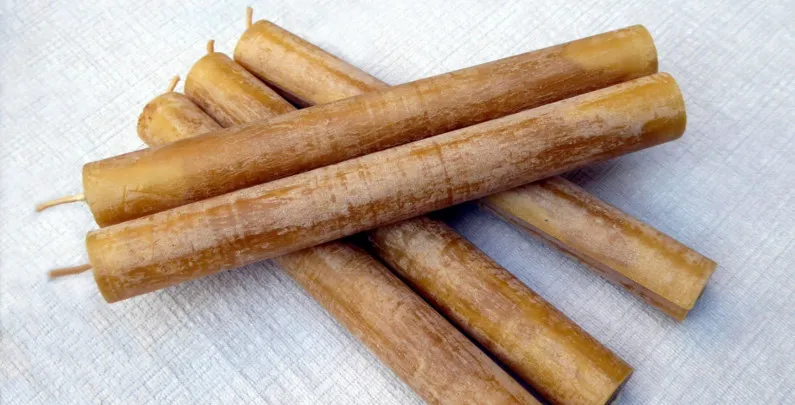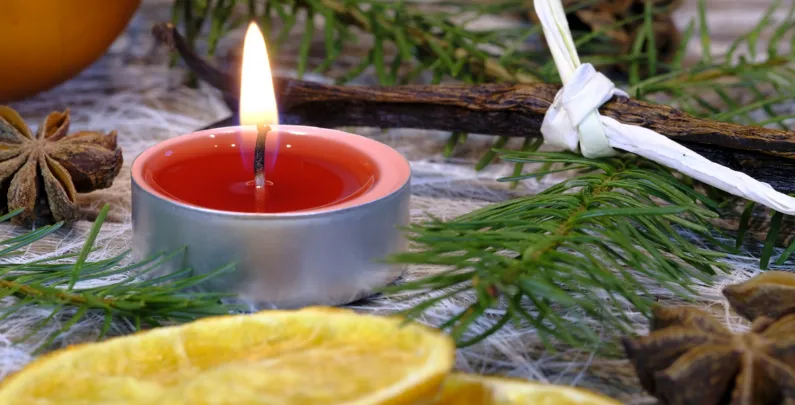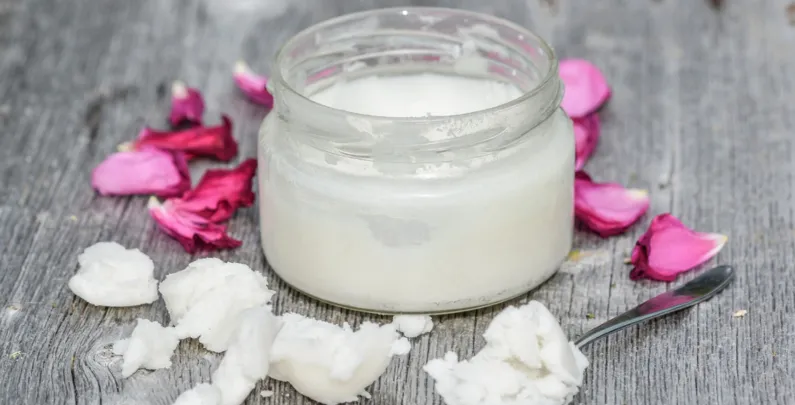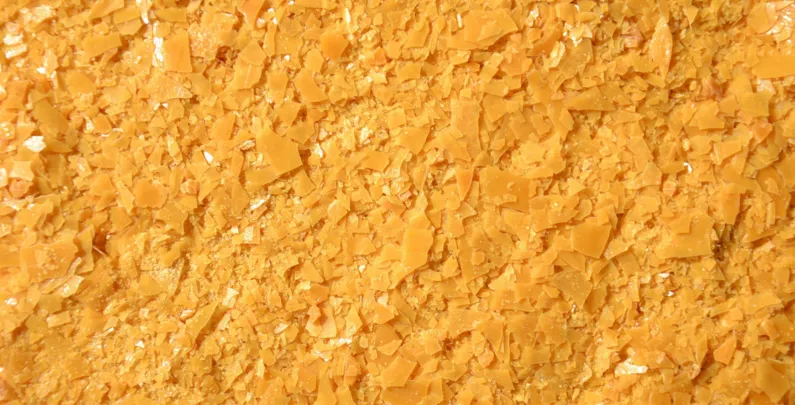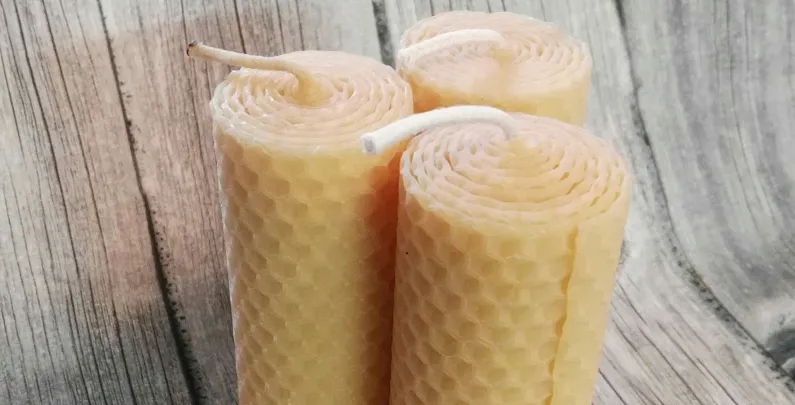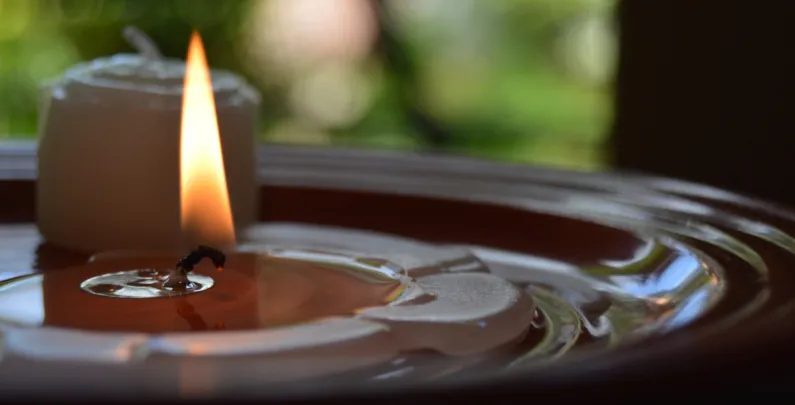Waxes may come in pellet, flakes, or block forms. In candle making or manufacturing process, this wax measured to the amount you need and then heated and melted into a near-liquid state in metal kettles or a double-boiler system. The size and type of the melting system depends on the quantity of wax being used. “Wax melted by direct flame can become dark-coloured or can contain small pieces of carbon char” (http://www.madehow.com/Volume-1/Candle.html).
The temperatures needed depend on the type of wax being used. Achieving the proper temperature is a crucial factor in creating the correct structure and uniform appearance of the wax. If the temperature is either too hot or too cold for the type of wax being used it can cause poor adhesion and may result in the candle being too hard, brittle, or soft.
This molten wax may then go through further filtration and at this stage any fragrances and dyes are added.
Fragrances
One of the leading factors that influences a consumer’s decision to buy a candle is fragrance. The scent of the candle can help mask other scents, such as sweat, and can help promote relaxation.
Because wax is not water soluble, colouring that contains water does not work, and so oils are used. Before using in candles these fragrance oils may be tested for solvency, absorption, flash point, specific gravity, and flammability. Additives such as vybar may also be used to increase the wax’s ability to retain higher fragrance loads.
Scent throw is the strength (intensity) and radius of the fragrance that is released from the candle. Cold scent throw is the aroma emitted when the candle is stored, and hot scent throw is the aroma emitted when the candle is lit or burning. A good scent throw (a strong scent that carries) is dependant on a proper burn pool. Most of the the aroma that comes from the fragrance in a candle is released through evaporation of the hot wax pool. Some of the scent may be released when the oil travels up the wick and its vapour combusts.
The aroma emitted from scented candles are a combination of three notes: the top note, the middle note, and the base note. These levels of scent work together to create a scent that is long lasting and pleasant.
The top note is the lightest, and is the initial impression you get when you first smell the fragrance oil or candle. It is the most volatile, which means it tends to evaporate the quickest. The middle note is the “body” of the fragrance and is the most prominent. It is smelled after the top notes have faded, a process that can take 10 to 20 minutes. The base note is the heaviest. It is smelled last, and can linger in the air for hours after the candle is extinguished. The base notes are what give the fragrance lasting qualities (“staying power”) and are essential in achieving good scent throw.
Fragrances that contain high levels of heavy bases notes such as musk may require a larger wick in order to travel up the wick and evaporate.
Some fragrance oils will travel up the wick more easily than others. They will also have different flash points and specific gravity. Flash points is the temperature at which the oil can combust when exposed to a flame. A candle with a higher flash point and specific gravity requires a hotter burning wick to allow the fragrance to evaporate out of the wax, while a candle with a lower flash point and specific gravity requires a smaller wick.
Each chemical component in a fragrance has a different flash point, which leads to widely variable flash points in the oils. Adding fragrances with a flash point that is lower than that of the wax may cause it to be “burned,” or deteriorated, resulting in a weak scent.
Finding the right concentration of fragrance depends on several factors, such as the type of wax, the size and shape of the finished candle, and the brand, type and components of the fragrance. Temperature of the wax is also a critical factor when incorporating the fragrance and to prevent the fragrance from dissipating or binding uniformly to the wax.
Two main types of fragrances used in candles include: essential oils and synthetic fragrance oils. Essential oils are derived from a natural substance, such as plant material, flowers, leaves, wood and grass, while synthetic fragrance oils may be reproduced synthetically using scientific methods.
Essential oils are the liquids obtained from distilling any part of a plant, including the seeds, roots, bark, stems, leaves, fruit, flowers, and branches. Therapeutic/aromatherapy essential oils are distilled directly from the plant itself without the use of additives.
Although essential oils are natural, that does not mean they are all suited for use in candles. Not all essential oils are meant to be subjected to high heat and can release harmful compounds. The combustion can change the molecular structure of the essential oil, which can destroy any potential medicinal or aromatherapy benefits it might have had and may make it unsafe.
An example is limonene. Limonene is a compound that occurs naturally in plants, such as in the peel of oranges and lemons. When you peel the lemon or orange, or crush the peel, some of the limonene is released into the air. Once released into the air, this limonene may react with trace amounts of naturally occurring ozone, causing one in every two limonene molecules to mutate into formaldehyde (http://www.telegraph.co.uk/news/health/news/12103003/Why-scented-candles-could-cause-cancer.html).
When released in small amounts, such as in the case of that released from orange or lemon peels, it is not known to be toxic. Limonene is still an important compound for health when consumed. However, candles may contain higher concentrations that may be released into the air when burned. This may result in the formation of higher concentrations of formaldehyde.
To use essential oils, you want to select those that can handle high temperatures, such as those produced through steam distillation, and then add them to the wax at low temperatures. Only certain waxes, such as soy and coconut wax, can melt at low enough temperatures to do that. Essential oils produced through pressing or solvent extraction may be too delicate to withstand the heat.
Trace amounts of the solvent can remain in the essential oil if it is not completely dissolved out before use. For that reason, it is recommended to look for solvent free essential oils.
Essential oils are more expensive than synthetic fragrances, and do not provide the same variety of scents or scent strength. They may also not blend as easily in waxes.
They do provide more depth in their aroma, and do not contain nearly as many carcinogens (cancer-causing substances) and other hazardous chemicals. You can also combine essential oils to create your own unique blend.
Diluents (a diluting agent) may be added to essential oils to thin them out so that they can travel up the wick and burn correctly. Diluents may include synthetic substances such as Isopropyl myristate, or di-Octyl Adipate, or natural substances such as fractionated coconut oil or soy oil.
A synthetic fragrance may be made from “natural” and synthetic ingredients, of which there is over 3000. These ingredients may include a carrier base, alcohols, aldehydes, esters, toluene, benzene, synthesizers, phthalates, and other synthetic compounds. Many of these chemicals are derived from petroleum. They may also contain natural isolates, a single chemical that is isolated from a plant and has a scent.
Phthalates are a group of chemicals often used as plasticizers, substances added to plastics to make them flexible, resilient, and easier to handle. They are also used in cosmetics, hairspray, fragrances, insecticides, and a number of other products. In fragrances, they are used as solvents, blenders, surfactants and fixatives to hold colour and scent and make them last longer.
While some phthalates have not currently been shown to have any effect on health, others, including diethyl phthalate (DEP) and dibutyl phthalate (DBP) have been linked to endocrine disruption (they can mimic or behave like certain hormones and interfere with normal hormonal activity in the body), altered reproductive function and development, fertility problems, organ toxicity, and a potential carcinogen. Children and pregnant women in particular should be cautious of using products that contain certain phthalates.
The full effect of phthalates on human health is not yet fully known or comprehensively studied. Europe has regulated and banned the use of some of these phthalates, including DEP, but they are still allowed in North America, where no labelling is required for fragrances.
Many of the natural ingredients in fragrances are still synthetic in that they are synthesized, or made, in a lab instead of being extracted. These types of hand-made “natural” compounds are known as nature-identical because they possess a chemical structure that is similar to its essential oil counterpart. Completely synthetic chemical compounds are those that do not exist in nature.
These ingredients are usually in the form of a liquid, powder, or crystalline, and must be dissolved by solvents to create the fragrance oil. Similar to essential oils, a diluent may also be used to adjust the density of the oil so that it can be pulled up the wick to be burned. It may also be added to some fragrances in order to reduce the strength so that it can be sold at a lower price. For both synthetic fragrances and essential oils you want to avoid diluents such as dipropylene glycol (DPG) because they can prevent the candle from burning properly.
The variety of compounds available mean that there is almost an unlimited amount of combinations or scents that can be created. This is how “sugar cookie” or “bubblegum” scents can be available since they do not naturally occur in nature.
Synthetic fragrances are often preferred because they are less expensive, more widely available, can be more easily combined with additives or other compounds to improve its ability to work with different types of wax, and can provide a more concentrated and consistent odour.
However, while the National Candle Association claims that properly formulated scented candles will primarily produce water vapour and carbon dioxide when burned, there is always the potential for any compound to be broken down during the pyrolysis process (the decomposition of material in the presence of high temperatures) and released into the air. A type of compound that may be released into the air include volatile organic compounds.
Volatile organic compounds (VOCs) are carbon-containing chemicals that have high vapour pressure, meaning they will readily evaporate and become vapours or gases at room temperature. Some VOCs occur naturally, while others may be synthetically produced. For instance, human’s release VOCs through their skin and when they exhale. Plants also produce a broad range of VOCs that play an important role in protecting them from stress and pathogens, attracting insects for pollination and seed dispersal, and as a form of communication or signalling to other plants, as well as animals.
VOCs may also be emitted by solvents, paints, air fresheners, pesticides, fire retardants, burning fuel, stored fuel and automotive products, hobby supplies, glue, correction fluids, and many building materials and household cleaning and disinfectant products. Most scents and odours, both natural and synthetic, are comprised of VOCs. Not all VOCS are harmful to health, but many are, including benzene, toluene, and aldehydes (including formaldehyde).
Health effects experienced depend on the type, concentration, and length of exposure to the VOC, but they can include irritation of the eyes, nose; and throat; headaches; loss of coordination; nausea; fatigue; dizziness; visual disorders; memory impairment; and damage to the liver, kidney, and central nervous system. A number of VOCs are considered to be proven or probable human carcinogens (cancer-causing substances) and have been shown to cause cancer in animals.
VOCs are a major contributor to indoor air pollution, and it is recommended to limit exposure.
Fragrance formulas are regarded as “proprietary” in North America, which means that fragrance manufacturers do not have to disclose the ingredients. They simply have to state “fragrance” on the label.
The fragrance, whether an essential oil or synthetic fragrance, must be compatible with your chosen wax and must be added using the right concentrations and temperatures, or they may cause a lumpy surface, poor adhesion, small diameter burn pools, poor scent throw, and poor burning properties, such as mushrooming or sooting.
Both essential oils and synthetic fragrances can be potential allergens that can aggravate asthma symptoms or cause other reactions in sensitive individuals, and should be selected and used with care.
After the wax and fragrance are incorporated, they should allowed time to “cure,” or given time to bind together.
In the next blog post, we will look into colourants.

